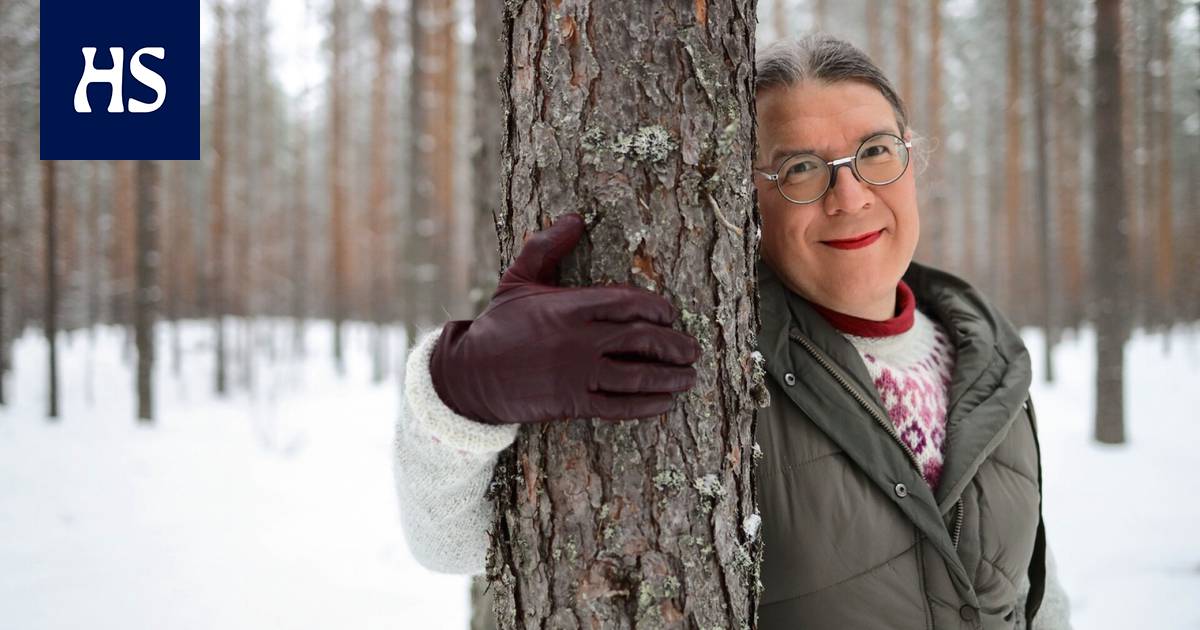Annamari Laurén predicts that as the summer heats up, ditches in bog forests will also have to be filled in order to save the forests’ yield.
“The tree and between the bark”, characterizes the recent professor of swamp forestry at the University of Helsinki Annamari Laurén the situation in the field.
At some point, he felt that nobody was interested in his research. Now there is no shortage of interest. The heated debate about carbon sinks and restoration has made Finnish forests a vulnerable area.
The excitement in the new position is also increased by the fact that the professorship at the University of Helsinki is the first position that Laurén applied for as a trans woman.
“I am quite proud and satisfied that it is possible nowadays. The world has changed for the better,” he says.
First however, we are talking about the management of Finnish forests. According to Laurén, people in the forest industry are embarrassed that they have started to be seen as the bad guys.
“That’s what you feel guilty about when you promote forestry.”
For decades, forestry faculties at universities have studied and taught forest management, which is sustainable at least from the point of view of forestry. It means that the trees grow as well as possible and a new forest is quickly replaced.
Other goals have also been promoted as society’s values have required in each period: efforts have been made, for example, to prevent the runoff of solid matter and nutrients from forest ditches into waterways.
Finnish society still has no intention of giving up the economic use of forests, but now we should also really take care of carbon sequestration and biodiversity.
When the professorship of swamp forestry was opened for applications, the field of work was renewed and it became quite different. The question of how to practice sustainable forestry on peatlands and at the same time adapt their use to other goals should be answered.
“
“Peat lands are Finland’s biggest carbon store, bigger than all the forests combined.”
How can different, partly conflicting goals be realized at the same time?
Lauren says the answer requires “rocket science”. That is, calculation and modelling, which can be used to assess the consequences of different forest management solutions.
Lauren has previously worked as a researcher at the Forest Research Institute and Luke, and as a professor of forest ecosystem modeling at the University of Eastern Finland. In these tasks, he has developed, for example, the swamp simulator Susi.
Value choices are not dictated by any simulator, but informed decisions can be made with the help of modeling.
In the swamps according to Laurén, is of great importance in the pursuit of carbon neutrality.
“Peatlands are Finland’s biggest carbon store, bigger than all the forests combined,” says Lauren.
“If the wrong choices are made in peatlands, carbon neutrality will not be achieved either.”
However, it cannot be achieved with the help of swamps and forests either, the most important thing is to give up fossil fuels, says Laurén.
II don’t know point of view, the basic problem of drained bog forests is that the drained peatland emits carbon dioxide and carbon dioxide emissions accelerate climate change.
The European Union demands the restoration of bogs also in order to stop the loss of nature. It means plugging ditches dug in swamps.
Laurén says that “environmental panic” does not help the climate or diversity, but actions must be chosen carefully.
“Otherwise, the money will be wasted and the goal will not be achieved.”
Starting point is, according to Laurén, this: Finland has 9–10 million hectares of bog. Half of that, or 5 million hectares, has been drained.
A million kilometers of ditches have been dug into the swamps. They would reach 25 times around the globe. Filling is slow machine work and costs a lot. With time, however, the ditches close by themselves.
A quarter of the annual growth of Finnish trees comes from drained peatlands. In other words, peatlands are of great economic importance.
However, there are countries where it is easy to start blocking ditches. A fifth of the drained swamp areas have not grown a forest. It makes sense to restore them.
“Or leave it to be restored.”
A small part of the marshes are nutrient-rich fens and hay ravens. They are densifications of diversity that should be restored and protected.
According to Laurén, these one million hectares are enough for a light start. They have 200,000 kilometers of ditches to plug.
The rest 70 percent of the drained bogs are now lingonberry or blueberry thickets, which grow well in the forest.
“They are like a diesel engine, producing steadily, although not peak growth,” says Laurén.
Forestry Laurén’s rocket science methods can help in the climate-friendly management of remaining peat forests.
According to Laurén, within thirteen years, one million hectares of peat forest will be of renewal age. The largest salt flats were drained in Finland more than 50 years ago.
In order to reduce carbon emissions, continuous cultivation can be practiced in spruce forests, i.e. the largest trees are picked from the forest during felling and the smaller ones are left to grow.
However, pine seedlings need light and, according to Laurén, they require punching a hole. He thinks it is important that clear-cutting and processed saplings are also left in the selection of forest renewal methods.
Logging after that, a new forest should be created in the area as quickly as possible, reduce the emissions of carbon dioxide and methane in the initial phase and minimize the emissions of nutrients into water bodies.
It is not self-evident how best to do it. Due to the complex feedback loops, it is difficult to predict the effects of different forest treatments.
The following graphics show some of the basic connections that Laurén mathematically models. Clicking on the image will change it.
How however much the Finnish forest manager tries to adjust the water level, it is ultimately decided by the rains. In dry summers, even natural bogs can turn from carbon sinks to emission sources.
If climate change brings more hot and dry summers, the drought will already start to disturb the growth of forests in southern Finland. Laurén predicts that forest ditches will have to be blocked in the future in order to save the yield of the forests.
“It is conceivable that even that is not enough.”
When private forests are protected, according to Laurén, it is wise to start on a voluntary basis.
There are 600,000 forest owners in Finland. They are a comprehensive cross-section of Finns, says Laurén. Many have a desire for conservation measures in their own countries.
If the practice of forestry on peatlands is prevented by law or certifications, the assets of forest owners in some areas may be completely reduced to zero.
“It would not be good for social peace.”
In remote areas, forest ownership is also a social issue, says Laurén. If the forest loses its value, its owner may not be able to get a loan, a leaky roof may remain unrepaired, and livelihoods may be insufficient.
“In addition to organisms, this also deals with people.”
Peat lands is especially high in North Ostrobothnia, for example. There, 70 percent of the forests are drained peatland.
From Laurén’s speech, it is said that she is from there. He says Really, like a person from Oulu, and no so, like the one from Helsinki.
The original dialect has been preserved, even though he went to study in Joensuu when he was young and has lived there most of his life.
Sometimes he also worked for Stora Enso in Indonesia.
“
“The academic world has been good. I have not experienced discrimination or belittlement.”
Lauren’s says that he already felt as a child that he did not belong among boys.
In adolescence, he received “a big scoop of testosterone”, and the problem was left in the background for a while.
In 2013, Laurén finally applied for the investigations of the transpol and received a diagnosis of transgender.
It was several more years before he came forward with the matter. It ended up being easier than he had thought.
“The academic world has been good. I have not experienced discrimination or belittlement.”
To everyone according to Laurén, they don’t want trans people in the workplace. The situation can also take so much strength that it is not enough to move forward professionally.
He himself says that he became a better, more creative and braver scientist when he no longer had to push the issue inside.
Laurén still does not support giving Trans treatments or self-determination of gender without examinations and diagnosis. The bill currently under consideration by the Parliament allows changing the legal gender marking by self-notification.
In Lauren’s opinion, it is good to have support and time to think about making a big decision. He did not feel that Transpol’s investigations were oppressive or discriminatory.
“The old system suited me very well. It was nice to talk, and it was necessary. I got the support I felt I needed,” says Laurén.
He still says he understands that waiting for someone else can feel painful. Especially young people are often in a hurry.
“There is more time when you are old than when you are young. The perception of time is different.”
-
Professor of Finnish forestry at the University of Helsinki.
-
Plays the flute, which he started in his forties.
-
The family consists of a spouse and two adult children.
#Forestry #professor #Finnish #forestry #tree #bark #combine #forestry #carbon #neutrality







